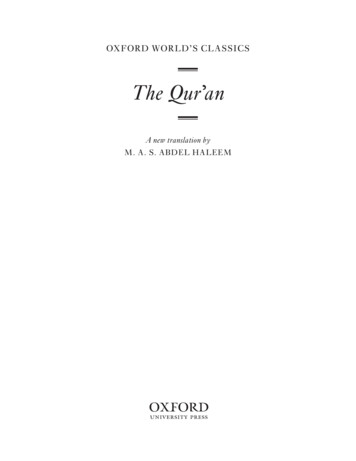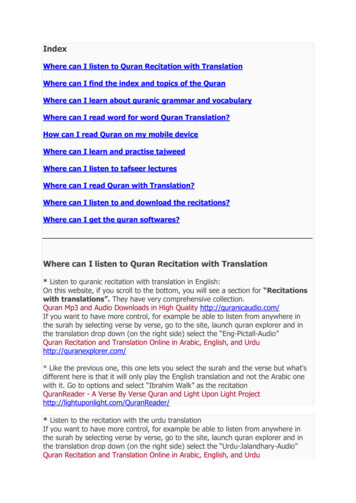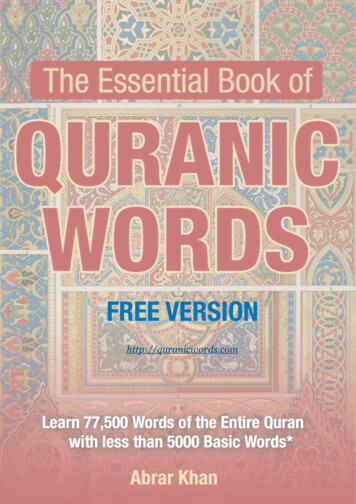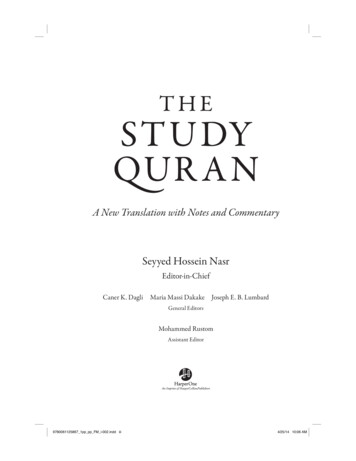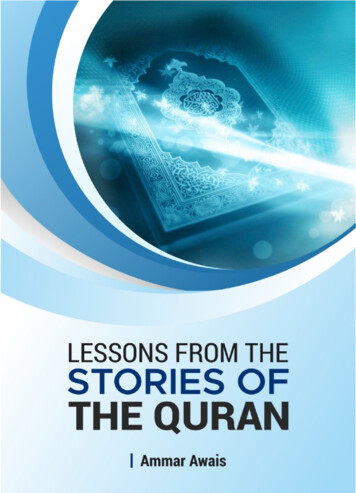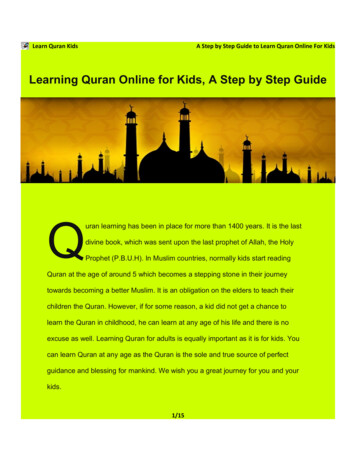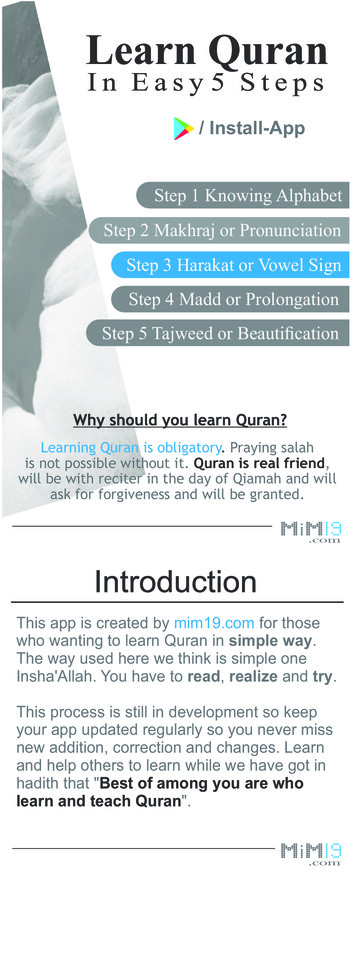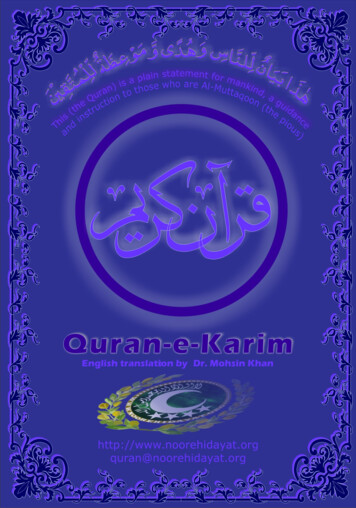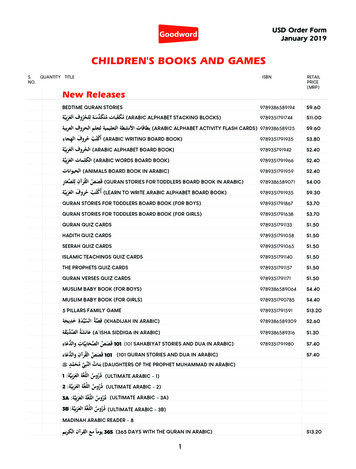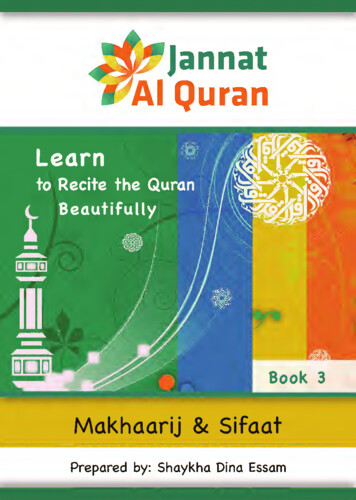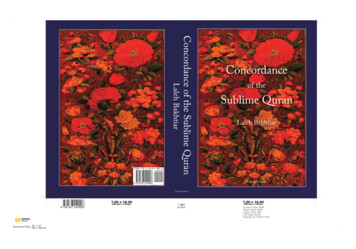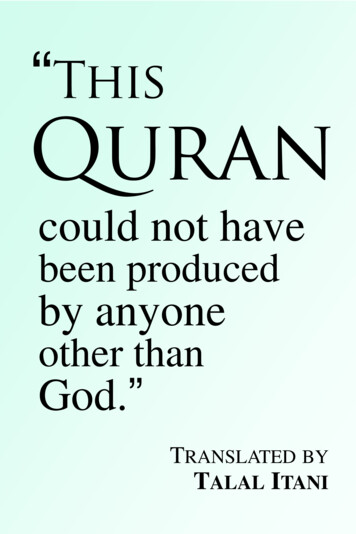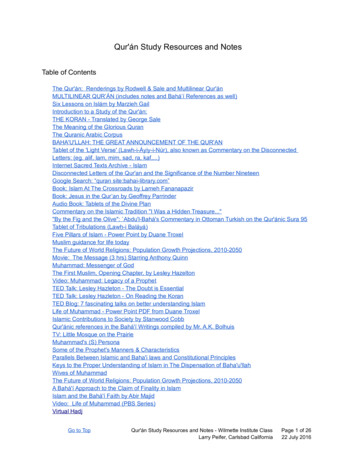
Transcription
Qur'án Study Resources and NotesTable of ContentsThe Qur'án: Renderings by Rodwell & Sale and Multilinear Qur'ánMULTILINEAR QUR’ÁN (includes notes and Bahá’í References as well)Six Lessons on Islám by Marzieh GailIntroduction to a Study of the Qur'án:THE KORAN - Translated by George SaleThe Meaning of the Glorious QuranThe Quranic Arabic CorpusBAHA'U'LLAH: THE GREAT ANNOUNCEMENT OF THE QUR'ANTablet of the 'Light Verse' (Lawh-i-Áyiy-i-Núr), also known as Commentary on the DisconnectedLetters: (eg. alif, lam, mim, sad, ra, kaf,.)Internet Sacred Texts Archive - IslamDisconnected Letters of the Qur'an and the Significance of the Number NineteenGoogle Search: “quran site:bahai-library.com”Book: Islam At The Crossroads by Lameh FananapazirBook: Jesus in the Qur’an by Geoffrey ParrinderAudio Book: Tablets of the Divine PlanCommentary on the Islamic Tradition "I Was a Hidden Treasure.""By the Fig and the Olive": Abdu'l-Bahá's Commentary in Ottoman Turkish on the Qur'ánic Sura 95Tablet of Tribulations (Lawḥ-i Baláyá)Five Pillars of Islam - Power Point by Duane TroxelMuslim guidance for life todayThe Future of World Religions: Population Growth Projections, 2010-2050Movie: The Message (3 hrs) Starring Anthony QuinnMuhammad: Messenger of GodThe First Muslim, Opening Chapter, by Lesley HazeltonVideo: Muhammad: Legacy of a ProphetTED Talk: Lesley Hazleton - The Doubt is EssentialTED Talk: Lesley Hazleton - On Reading the KoranTED Blog: 7 fascinating talks on better understanding IslamLife of Muhammad - Power Point PDF from Duane TroxelIslamic Contributions to Society by Stanwood CobbQur'ánic references in the Bahá'í Writings compiled by Mr. A.K. BolhuisTV: Little Mosque on the PrairieMuhammad's (S) PersonaSome of the Prophet's Manners & CharacteristicsParallels Between Islamic and Baha'i laws and Constitutional PrinciplesKeys to the Proper Understanding of Islam in The Dispensation of Baha'u'llahWives of MuhammadThe Future of World Religions: Population Growth Projections, 2010-2050A Bahá'í Approach to the Claim of Finality in IslamIslam and the Bahá'í Faith by Abir MajidVideo: Life of Muhammad (PBS Series)Virtual HadjGo to TopQur'án Study Resources and Notes - Wilmette Institute ClassLarry Peifer, Carlsbad CaliforniaPage 1 of 2622 July 2016
The Hadith of the Prophet Muhammad ( )صلى ا عليه و سلم at your fingertipsOxford Islamic Studies OnlineAn Episode in the Childhood of the BabThe Life of the BabIslamic Schools and BranchesSigns of the Last DayAkka Traditions (hadith) in the Epistle to the Son of the WolfAs to whether Ishmael or Isaac were to be sacrificed, here are some statements by Shoghi Effendi:The Unity of Religions in This Century, Jews and the Crucifixion, and the Sacrifice of IshmaelTablet to Hájí Mírzá Kamálu'd-Dín:Baha'u'llah's Visitation Tablet for Imam HusaynTablet of Visitation for Imám HusaynKitáb-i-Aqdas (Most Holy Book): Notes on the Style of the Kitáb-i-AqdasPhoto: The Cave of HiraTimeMaps: Civilization: The Islamic CaliphateBaha'u'llah's prophetology: Archetypal patterns in the lives of the founders of the world religionsLife of Prophet Muhammad (pbuh) - His Physical AppearanceTraditions regarding the Imam Muhammad, The 12 Imam,The One Who Related the Existence of the Qáʼim by Bahá'u'lláhA prerequisite of admittance into the Bahá'í fold is the acceptance of the legitimacy of the institution ofthe ImamateShi i Islam by Moojan Momen 1995From the Jabulqa of God's Power to the Jabulqa of Superstition: The Twelfth Imam in the Writings ofBahá'u'lláh and Abdu'l-Bahá'Islam in Iran - The Concept of Mahdi in Twelver Shi’ismḠAYBA (Pers. ḡaybat) lit. "absence"; term used by the Shiʿites to refer to the occultation of theHidden ImamBaha'u'llah is to Shi'ah Islam the return of Husayn (God Passes By, 94), and that the Bab is of theseed of FatimihImam ‘AliPortal:Sufism fismSufi and Baha'i Spiritual Practices by Michael McCarron, 2009Baha'u'llah's Commentary on a Verse of RumiSymbolic Cosmology in the Sufi and Bahá'í traditionsIbn ArabiThe Concept of the "Perfect Man" (Pole) in Sufism and the Bahá'í Notion of the Manifestation of GodReflections on Some Messianic Prophecies in Shaykhi WorksMysticism and the Bahá'í Faith by Farnaz Ma'sumianBahá'u'lláh and MysticsThe Remembrance of God: An Invocation Technique in Sufism and the Writings of The Báb andBahá'u'lláhThe Baha’i Faith is thus fundamentally mystic in characterPoem of the Dove (or Al- Qasidah-al-Warqa'iyyah)Ode of the Dove by Bahá'u'lláhBaha'u'llah's Notes to His "Ode of the Dove" by Bahá'u'lláhMuhyiddin Ibn 'Arabi 1165 -1240ADThe Muhyiddin Ibn 'Arabi SocietyIbn al- Arabi in the Baha'i Writings By Muin AfnaniGo to TopQur'án Study Resources and Notes - Wilmette Institute ClassLarry Peifer, Carlsbad CaliforniaPage 2 of 2622 July 2016
The God of Bahá’u’lláhThe Worlds of GodThe Oldest Quran in the WorldKARAMAH: Muslim Women Lawyers for Human RightsGender Equality in IslamVideo: Muslim Christian DialogueInterfaith ExplorersWomen in the QuranThese research notes and links do not represent official Bahá’í positions and are purely the result of anindividual project. All the comments are those of the author and are not necessarily those of the Bahá’ícommunity. If you find any inaccuracies or errors in this document, please let me know by sending anemail to larrypeifer@hotmail.comGo to TopQur'án Study Resources and Notes - Wilmette Institute ClassLarry Peifer, Carlsbad CaliforniaPage 3 of 2622 July 2016
The Qur'án: Renderings by Rodwell & Sale and Multilinear Qur'ánwith Bahá'í References by Verse, compiled by Brett Zamir. Renderings into English by George Sale andJ.M. Rodwell (Ed. Note: This is a rich link for a wealth of Qur’an / Baha’i related material)http://bahai-library.com/quran rodwell sale zamirMULTILINEAR QUR’ÁN (includes notes and Bahá’í References as ml(An xls version is downloaded to my Dell PC)Six Lessons on Islám by Marzieh Gail(Approved by Bahá'í Reviewing Committee)http://bahai-library.com/gail lessons islamIntroduction to a Study of the Qur'án:With Additional References from Several Bahá'í Texts by Study Outline Committee of the NationalSpiritual Assembly of the Bahá'ís of the United States, Wilmette: Bahá'í Publishing Trust, 1941http://www.bahai-library.com/nsa introduction study quranTHE KORAN - Translated by George SaleTranslated into English from the Original Arabic with explanatory notes takes from the most n/quran.html (Best in browser)http://bahai-library.com/quran/quran.doc (Best in word processor)The Meaning of the Glorious QuranText, Translation & Commentary by: Abdullah Yusuf Alihttp://www.islamicbulletin.org/free downloads/quran/quran yusuf ali2.pdfThe Quranic Arabic Corpushttp://corpus.quran.com/An annotated linguistic resource which shows the Arabic grammar, syntax and morphology for each wordin the Holy Quran. The corpus provides three levels of analysis: morphological annotation, a syntactictreebank and a semantic ontology. (Audio recitation available also).BAHA'U'LLAH: THE GREAT ANNOUNCEMENT OF THE QUR'ANBy Muhammad Mustafa,, Translated by Rowshan Mustafa, Edited and Annotated by Laura M. Herzog,Baha'i Publishing Trust, Dhaka, ent.quran/This book was prepared to assist English-speaking Baha'is to acquire a basic understanding of issuesfrequently raised by Muslims with regard to the Qur'an and the Baha'i Faith. It was originally written in1959 when the writer was asked to undertake such a task by Baha'is in Liberia, during his visit to thatcountry. Recently it has been rewritten and expanded, so that it addresses many subjects of particularinterest to Muslims.Go to TopQur'án Study Resources and Notes - Wilmette Institute ClassLarry Peifer, Carlsbad CaliforniaPage 4 of 2622 July 2016
In The Promised Day Is Come, Shoghi Effendi writes of the attitude of the Baha'i Faith towards Islam,from which the following excerpt is taken:As to Muhammad, the Apostle of God, let none among His followers who read these pages, thinkfor a moment that Islam, or its Prophet, or His Book, or His appointed Successors, or any of Hisauthentic teachings, have been, or are to be in any way, or to however slight a degree,disparaged. The lineage of the Bab, the descendant of the Imam Husayn; the divers and thestriking evidences, in Nabil's Narrative, of the attitude of the Herald of our Faith towards theFounder, the Imams, and the Book of Islam; the glowing tribute paid by Baha'u'llah in the Kitab-iIqan to Muhammad and His lawful Successors, and particularly to the "peerless andincomparable" Imam Husayn; the arguments adduced, forcibly, fearlessly, and publicly by 'Abdu'lBaha, in churches and synagogues, to demonstrate the validity of the Message of the ArabianProphet; and last but not least the written testimonial of the Queen of Rumania, who, born in theAnglican faith and not withstanding the close alliance of her government with the Greek OrthodoxChurch, the state religion of her adopted country, has, largely as a result of the perusal of thesepublic discourses of 'Abdu'l-Baha, been prompted to proclaim her recognition of the propheticfunction of Muhammad - all proclaim, in no uncertain terms, the true attitude of the Baha'i Faithtowards its parent religion.Tablet of the 'Light Verse' (Lawh-i-Áyiy-i-Núr), also known as Commentary on theDisconnected Letters: (eg. alif, lam, mim, sad, ra, kaf,.)What on earth is a disconnected letter? Baha'u'llah's commentaryhttp://bahai-library.com/marshall disconnected lettersInternet Sacred Texts Archive - nsive resources for Islam: Qur’an version, Hadith, Sufi Texts, Islamic History and Culture.(Patent url has extensive sacred texts from a huge array of ideologies)Disconnected Letters of the Qur'an and the Significance of the Number Nineteenby Robert T. Cameron, 1997http://bahai-library.com/cameron disconnected letters nineteenWhat do the disconnected letters which preface many surihs of the Qur'an mean? Bahá'u'lláh says, "Inthe disconnected letters of the Qur'an the mysteries of the divine Essence are enshrined, and within theirshells the pearls of His Unity are treasured." He also states, "Outwardly they signify MuhammadHimself." If anyone knew the meanings of these disconnected letters they would have no doubt oruncertainty about the Divinity of Muhammad or the divine origin of His Book. They are,".the supremeinstrument of guidance for attainment unto the loftiest summits of knowledge.Google Search: “quran bhp?sourceid chrome-instant&ion 1&espv 2&ie UTF-8#q quran%20site%3Abahai-library.comBook: Islam At The Crossroads by Lameh FananapazirGeorge Ronald, Publisher, Oxford, 2015, www.grbooks.comGo to TopQur'án Study Resources and Notes - Wilmette Institute ClassLarry Peifer, Carlsbad CaliforniaPage 5 of 2622 July 2016
Book: Jesus in the Qur’an by Geoffrey ParrinderThis book has been written primarily for readers in the western world, the general public as well asstudents of theology and the comparative study of religions. But is it hoped that it may also be useful tosome people in Asia and Africa who have asked for a modern and impartial study of the teaching of theQur’an about Jesus, which seems to be unobtainable in English or Arabic.Audio Book: Tablets of the Divine abletsOfTheDivinePlan.zipCommentary on the Islamic Tradition "I Was a Hidden Treasure."by Abdu'l-Bahá, translated by Moojan Momen. published in Bahá'í Studies Bulletin, 3:4, pages 4-351995-12, originally written as "Tafsír-i-Hadith-i-Kuntu Kanzan Makhfíyyan".http://bahai-library.com/abdulbaha kuntu kanzan makhfiyyan"By the Fig and the Olive": Abdu'l-Bahá's Commentary in Ottoman Turkish on theQur'ánic Sura 95by Necati Alkan, published in Bahá'í Studies Review, 10, pages 115-126, London: Association for Baha'iStudies English-Speaking Europe, 2001http://bahai-library.com/alkan fig oliveFor the first time an Ottoman-Turkish Tablet by Abdu'l-Bahá will be presented. The original text appearsin a collection of Tablets and Prayers by Abdu'l-Bahá in Ottoman-Turkish. Abdu'l-Bahá comments on theverse By the Fig and the Olive (wa't-tin wa'z-zaytun), indeed, He presents a commentary on the entiresura. The four sacred symbols Fig, Olive, Mount Sinai and Mecca, "the City of security" will be studied inBiblical, and Qur'anic context previous to Abdu'l-Bahá's exegesis in this Tablet.Tablet of Tribulations (Lawḥ-i .pdfBaha’u’llah rarely compares his sufferings to those of Muhammad, preferring instead to parallel hismistreatment to that of Muhammad’s martyred grandson Husayn. But the comparison with Muhammad isapt if for no other reason than both men lived long lives as self-proclaimed prophets and died peacefullyin their beds. One of the few places Baha’u’llah makes the comparison is in the “Tablet of Tribulations,”written between 1863 and Baha’u’llah’s death in 1892. In it, he draws a stark contrast between histribulations and those of Muhammad. Given his allusion to the calumnies directed against him by twounnamed individuals, Baha’u’llah probably wrote the tablet during his exile in Istanbul and Edirne between1863 and 1868 when the Iranian ambassador to the Ottoman Empire and Sayyid Muhammad Isfahaniconspired against him.Five Pillars of Islam - Power Point by Duane .pptGo to TopQur'án Study Resources and Notes - Wilmette Institute ClassLarry Peifer, Carlsbad CaliforniaPage 6 of 2622 July 2016
Muslim guidance for life todayTwo wonderful sites for day to day issues in America and around the world.http://www.soundvision.com/ www.radioislam.comOur websites, www.soundvision.com, and, www.radioislam.com, occupy a unique position on the internet.Not only are Muslims from all over the world logging on in ever increasing numbers, they are accessing awealth of practical Islamic information through weekly updates and informative programming. Thisknowledge can, Insha Allah, be shared by individuals and communities alike.The Future of World Religions: Population Growth Projections, 2010-2050Why Muslims Are Rising Fastest and the Unaffiliated Are Shrinking as a Share of the World’s PopulationPew Research -projections-2010-2050/Movie: The Message (3 hrs) Starring Anthony Quinnhttp://www.dailymotion.com/video/x2ewzp3 the-message-full-movie-in-english shortfilmsMuhammad: Messenger of God(This article was written by Hesham A. Hassaballa and Kabir Helminski and is excerpted from their 2006book: "The Beliefnet Guide to Islam")(pdf file in google drive)The First Muslim, Opening Chapter, by Lesley Hazeltonhttp://thefirstmuslim.com/?page id 7Video: Muhammad: Legacy of a a-prophet/watch/(Other Islam related movies at the UPF site http://www.upf.tv/films/)TED Talk: Lesley Hazleton - The Doubt is Essentialhttps://www.ted.com/talks/lesley hazleton the doubt essential to faith?language enTED Talk: Lesley Hazleton - On Reading the Koranhttps://www.ted.com/talks/lesley hazelton on reading the koran?language enTED Blog: 7 fascinating talks on better understanding tter-understanding-islam/Life of Muhammad - Power Point PDF from Duane eligions/02-%20LIFE%20OF%20MUHAMMAD.pptIslamic Contributions to Society by Stanwood r'ánic references in the Bahá'í Writings compiled by Mr. A.K. referencelistsGo to TopQur'án Study Resources and Notes - Wilmette Institute ClassLarry Peifer, Carlsbad CaliforniaPage 7 of 2622 July 2016
TV: Little Mosque on the .cbc.ca/littlemosque/episodes.php(only Season 1 free, 2-8 subscribe)Hulu has all 8 Seasons if ks using VPN Canada)(TunnelBear)Muhammad's (S) htmlSome of the Prophet's Manners & het-muhammad-characteristics.htmParallels Between Islamic and Baha'i laws and Constitutional Principlesby Afshin A. Khavari, 1998http://bahai-library.com/khavari islamic bahai lawThe roles of Sunnah, Hadith, and Ijtihad in Islamic constitutional law, and the development of the Baha'ilegal order and its unique approach to law-making.Keys to the Proper Understanding of Islam in The Dispensation of Baha'u'llahby Brian Wittman, published in Lights of Irfan, 2, pages 135-48, Wilmette, IL: Irfan Colloquia, 2001http://bahai-library.com/wittman understanding islam.htmlThe Dispensation of Bahá’u’lláh, Shoghi Effendi's concise statement of the fundamental verities of Bahá’íbelief, contains a number of important keys which lead Bahá’ís to a more complete understanding ofIslam . The Dispensation upholds Islam as an independent religion and confirms the Imams as thelegitimate successors of Muhammad. ‘Alí's appointment by Muhammad as His successor was madeverbally and is not to be found in the Qur’án.Wives of Muhammadhttps://en.wikipedia.org/wiki/Muhammad%27s wives#Timeline of marriagesMuhammad's wives or Wives of Muhammad were the thirteen women married to the Islamic prophet.(Note: Wonderful charts and diagrams. See link for details of each wife.)Wives of MuhammadThe title "Mother of the Believers" in Arabic scriptKhadija bint Khuwaylid (595-620)Sawda bint Zamʿa (620-632)Aisha bint Abi Bakr (620-632)Hafsa bint Umar (625-632)Zaynab bint Khuzayma (626-627)Hind bint Abi Umayya (627-632)Zaynab bint Jahsh (627-632)Juwayriyya bint al-Harith (628-632)Go to TopQur'án Study Resources and Notes - Wilmette Institute ClassLarry Peifer, Carlsbad CaliforniaPage 8 of 2622 July 2016
Safiyya bint Huyayy (628-632)Ramla bint Abi Sufyan (629-632)Maymunah bint al-Harith (629-632)Maria bint Sham'ûnRayhana bint ZaydAisha - 2nd or 3rd wife of Muhammad who was betrothed as a child.https://en.wikipedia.org/wiki/AishaThe Future of World Religions: Population Growth Projections, 2010-2050Why Muslims Are Rising Fastest and the Unaffiliated Are Shrinking as a Share of the World’s ious-projections-2010-2050/A Bahá'í Approach to the Claim of Finality in Islamby Seena Fazel and Khazeh Fananapazir published in Journal of Bahá'í Studies, 5:3, pages 17-40Association for Baha'i Studies North America, 1993http://bahai-library.com/fananapazir fazel finality islam(Persian version also available at the site)Seal of the Prophets(33:40:9)rasūla(he is the) MessengerN – accusative masculine noun اسم منصوب (33:40:10)l-lahi(of) AllahPN – genitive proper noun Allah لفظ الجللة مجرور (33:40:11)CONJ – prefixed conjunction wa (and)wakhātamaand SealN – accusative masculine noun الواو عاطفة اسم منصوب (33:40:12)l-nabiyīna(of) the Prophets.Go to TopN – genitive masculine plural noun اسم مجرور Qur'án Study Resources and Notes - Wilmette Institute ClassLarry Peifer, Carlsbad CaliforniaPage 9 of 2622 July 2016
Chapter (33) sūrat l-aḥzāb (The Combined Forces)Sahih International: Muhammad is not the father of [any] one of your men, but [he is] the Messenger ofAllah and last of the prophets. And ever is Allah , of all things, Knowing.Pickthall: Muhammad is not the father of any man among you, but he is the messenger of Allah and theSeal of the Prophets; and Allah is ever Aware of all things.Yusuf Ali: Muhammad is not the father of any of your men, but (he is) the Messenger of Allah, and theSeal of the Prophets: and Allah has full knowledge of all things.Shakir: Muhammad is not the father of any of your men, but he is the Messenger of Allah and the Last ofthe prophets; and Allah is cognizant of all things.Muhammad Sarwar: Muhammad is not the father of any of your males. He is the Messenger of God andthe last Prophet. God has the knowledge of all things.Mohsin Khan: Muhammad (SAW) is not the father of any man among you, but he is the Messenger ofAllah and the last (end) of the Prophets. And Allah is Ever AllAware of everything.Arberry: Muhammad is not the father of any one of your men, but the Messenger of God, and the Seal ofthe Prophets; God has knowledge of -------------------------------Below is a nice commentary on the 'seal' of the prophets:(The following information if found online at http://bahai-library.com/fananapazir fazel finality islamwhere there is a much more inclusive discussion of this topic; including how Baha'u'llah explains 'seal')The Founder of Islam as KhátamAs indicated earlier, many traditions exist which take the phrase khátam al-nabiyyín (seal of the prophets)to mean "the last prophet." However, the completion of some activity is only one meaning of "seal". Thehistorical use of this word provides other interpretations as follows.Sealing may also be a guarantee of authenticity, or a device designed to prevent the unauthorisedopening of a receptacle without knowledge of the owner. In pre-Muslim Arabia, seals were used in placeof a signature, giving validity to a document. They were also utilised as a guarantee that property waskept intact and thus took the place of locks and keys. The possession of another person's seal wasevidence that the latter had delegated his authority. Pharaoh, for example, gave Joseph his signet as asign of authority (Gen 41:42). Jezebel forged a letter in Ahab's name and sealed it with Ahab's seal to giveit validity (1 Kings 21:8). Tradition has a certain amount to say about Muhammad's khátam (seal). Forinstance, Al-Bukhari recounts that the Prophet wished to write to the Byzantines, and was told that itwould not be read unless it had a seal on it. He therefore adopted a silver seal with the inscription Muhammad rasúl Alláh' at the year 7 A.H. (Allan, Khátam 1103).The expression khátam al-nabiyyín (seal of the prophets) is found in several places in classical Arabicpoetry. A verse in the Díwán of Umayya b. Abí al-Salt speaks of the Prophet as the one "by means ofGo to TopQur'án Study Resources and Notes - Wilmette Institute ClassLarry Peifer, Carlsbad CaliforniaPage 10 of 2622 July 2016
whom God sealed [khatama] the prophets [nabiyyín] before him and after him" (Prophecy 57). This verseimplies the appearance of prophets after Muhammad, so that the verb khatama here cannot beunderstood to mean the termination of something. Friedmann suggests the possibility that it means "hestamped upon them his seal [of approval]" (ibid). This idea that the Prophet came to confirm the formerprophets is supported by Qur'án 37:37: "he cometh with truth and confirmeth the Sent Ones [mursalin] ofold."There are other indications that the belief in the finality of Muhammad's prophethood was not generallyaccepted in the early days of Islam. In a gloss explaining the expression of khayr al-khawátim (the best ofthe seals) used in the Naqá'id, the commentator Abú Ubayda who died in 209 A.H. says, "He [the poet]means that the Prophet . . . is the seal of the prophets, which means he is the best of the prophets"(Naqá'id 349). A similar interpretation is given by Abú Riyásh al-Qaysí in his commentary on al-Kumayt'sHáshimiyyat. Commentating on a verse in which the prophet is referred to as khátam (or khátim) alanbiyá', Abú Riyásh says that the meaning of khátim al-anbiyá' is someone who seals the prophets;khátam al-anbiyá', on the other hand, means "beauty of the prophets" or "the best of them" (Friedmann,Prophecy 57). Another explicit tradition that supports this idea is attributed to Á'isha, who said, "Say [thatthe Prophet is] the seal of the prophets and do not say that there is no prophet after him" (Al-Suyúti, qtd.in Friedmann, Prophecy 63). The phrase khátam al-nabiyyín (seal of the prophets) here cannot mean "thelast prophet", but is understandable in the sense of the best prophet. Also, the foremost Kúfí grammarianal-Tha'lad held that "al-khátim is the one who sealed the prophets and al-khátam is the best of theprophets in character and physical constitution" (Al- Ayní, qtd. in Friedmann, Prophecy 58).These doxological interpretations of seal seem to indicate that even in the third century of Islam, there stillexisted different interpretations of khátam al-anbiyá' (seal of the prophets). These interpretations alsofound their way into hadíth literature. For instance, there is a saying of the Imam Alí that "Muhammad isthe Seal of the Prophets [khátam al-anbiyá'] and I am the Seal of the Successors [khátam al-wasiyyín]"(Majlisí,Bihár 4-5). If seal solely meant termination, then how can one understand Alí as sealing thesuccessorship, when there were to be eleven Imams after him according to Shi i belief and the Caliphatewas to continue after him in the history of Sunni Islam? Also, one Bahá'í writer discusses the implicationsof a hadíth in which the Prophet is reported to have said, "I am the last prophet and the mosque I amconstructing is the last mosque." Rawshani argues that if by the term "last mosque" is understood that noother mosque will be built in the dispensation of Islam, then clearly this is an absurd contradiction, unlessit was used in a doxological manner. On this ground the term khátam al-nabiyyín (seal of the prophets)refers to the fact that the Prophet confirmed the prophets before him and thus the peoples of Arabia, whohad not accepted the prophethood of the prophets of the past, particularly those of the Abrahamictradition, were summoned to recognise them (Rawshani, Khátamiyyat 30-31). Moreover, there are variantmeanings of seal suggested in the Qur'án; one verse states that on the Day of God a choice' wine willquench the thirst of the Righteous, "whose seal [khitám] is musk" (83:26).In summary, there is cogent evidence to suggest that the word khátam (seal) did not mean the last' in atemporal sense to early Muslims. There are instances in classical Arabic poetry and hadíth literature tosuggest that the word khátam (seal) was used to mean the one who confirmed' (the prophets of thepast), and understood in a honorific way as the best' (of the -------------------------Bahá'u'lláh wrote:' .how many are those who, through failure to understand its meaning, have allowed the term "Seal ofthe Prophets" to obscure their understanding, and deprive them of the grace of all His manifold bounties!Hath not Muhammad, Himself, declared: "I am all the Prophets?" Hath He not said as We have alreadyGo to TopQur'án Study Resources and Notes - Wilmette Institute ClassLarry Peifer, Carlsbad CaliforniaPage 11 of 2622 July 2016
mentioned: "I am Adam, Noah, Moses, and Jesus?" Why should Muhammad, that immortal Beauty, Whohath said: "I am the first Adam" be incapable of saying also: "I am the last Adam"? For even as Heregarded Himself to be the "First of the Prophets" - that is Adam - in like manner, the "Seal of theProphets" is also applicable unto that Divine Beauty. It is admittedly obvious that being the "First of theProphets," He likewise is their "Seal." . '- Book of CertitudeIslam and the Bahá'í Faith by Abir Majid(Available in English and Arabic)http://bahai-library.com/bic islam bahai faithVideo: Life of Muhammad (PBS rtual lso, timeline, resources, and learning tools.The Hadith of the Prophet Muhammad ( )صلى ا عليه و سلم at your fingertipshttp://sunnah.com/Oxford Islamic Studies Onlinehttp://www.oxfordislamicstudies.com/This authoritative, dynamic resource brings together the best current scholarship in the field for students,scholars, government officials, community groups, and librarians to foster a more accurate and informedunderstanding of the Islamic world. Oxford Islamic Studies Online features reference content andcommentary by renowned scholars in areas such as global Islamic history, concepts, people, practices,politics, and culture, and is regularly updated as new content is commissioned and approved under theguidance of the Editor in Chief, John L. Esposito.An Episode in the Childhood of the Babby Stephen Lambden published in In Iran: Studies in Babi and Bahá'í History vol. 3, ed. Peter Smith,pages 1-32, Los Angeles: Kalimat Press, 1986.http://bahai-library.com/lambden episode childhood babParallels legends of the Bab's early childhood with those of Jesus.The Life of the Babby Asadu'llah Fadil Mazandarani published in Star of the West, Set 7, Vol 14, Num 7, page ndarani lifebab sowLife of the Bab by the historian Jinab-i-Fadil (Asadu'llah Fadil Mazandarani)Islamic Schools and Brancheshttps://en.wikipedia.org/wiki/Islamic schools and branchesExcellent survey with wonderful charts and diagrams.Go to TopQur'án Study Resources and Notes - Wilmette Institute ClassLarry Peifer, Carlsbad CaliforniaPage 12 of 2622 July 2016
Signs of the Last Dayhttp://www.islamhk.com/HY/signsofthelastday/the rejection of the true religion.htmlStatements of unknown quality regarding all manner of the ‘Last Day’ as taught in the Quran.Akka Traditions (hadith) in the Epistle to the Son of the Wolfby Moojan Momen published in Lights of Irfan, Volume 4, pages 167-178, Wilmette, IL: Irfan Colloquia,2003http://bahai-library.com/momen hadith eswhttp://irfancolloquia.org/u/momen akkaAs to whether Ishmael or Isaac were to be sacrificed, here are some statements byShoghi Effe
The Meaning of the Glorious Quran The Quranic Arabic Corpus BAHA'U'LLAH: THE GREAT ANNOUNCEMENT OF THE QUR'AN . OF THE QUR'AN Tablet of the 'Light Verse' (Lawh-i-Áyiy-i-Núr), also known as Commentary on the Disconnected Letters: (eg. alif, lam, mim, sad, ra, kaf,.) Internet Sacred Texts Archive - Islam
